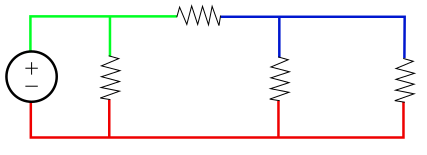Node (circuits)
Topic: Physics
 From HandWiki - Reading time: 2 min
From HandWiki - Reading time: 2 min
Short description: Region of an electrical circuit between two components
In electrical engineering, a node is any region on a circuit between two circuit elements. In circuit diagrams, connections are ideal wires with zero resistance, so a node consists of the entire section of wire between elements, not just a single point.[1]
Details
According to Ohm's law, V = IR, the voltage V across any two points of a node with negligible resistance R is
- [math]\displaystyle{ V = IR = I\cdot 0 = 0, }[/math]
showing that the electric potential at every point of a node is the same.
There are some notable exceptions where the voltage difference is large enough to become significant:
- High-precision resistance measurements using a Kelvin connection
- The difference in voltage between ground and neutral, between the neutral wire and the ground in domestic AC power plugs and sockets, can be fatal. A properly installed electrical system connects them together at only one location, leading many people to the fatally incorrect conclusion that they are at "the same" voltage, or that the safety ground is "redundant and unnecessary"
- The Seebeck effect and the Peltier effect
- Joints involving aluminium wire
Dots used to mark nodes on a circuit diagram are sometimes referred to as meatballs.[2]
References
 |
Licensed under CC BY-SA 3.0 | Source: https://handwiki.org/wiki/Physics:Node_(circuits)15 views | Status: cached on September 19 2024 00:19:58↧ Download this article as ZWI file
 KSF
KSF
